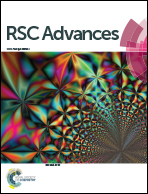Design, syntheses and evaluation of benzoylthioureas as urease inhibitors of agricultural interest†
Abstract
Urea is one of the most used nitrogen fertilizers worldwide. However, occurrence of urea hydrolysis to ammonia and carbon dioxide on soil surface, catalyzed by soil ureases, considerably reduces nitrogen availability to crops. In this study, we describe the design, synthesis and screening of sixty five benzoylthioureas (BTUs) for their ability to inhibit purified jack bean and soil ureases. BTUs were readily obtained in one pot, two steps synthesis with no need of cumbersome procedures for product purification. In vitro assays revealed BTUs 11, 12, 14, 19–22 and 37 as the most active jack bean urease inhibitors. Such BTUs were found to be able to bind to both catalytic and allosteric sites of urease, acting therefore as mixed-type inhibitors. Out of 28 compounds that effectively inhibited soil ureases activity, BTUs 3, 6, 10, 12, 16, 19 and 22 were determined to be more potent than the reference inhibitor N-(butyl) thiophosphoric triamide (NBPT; 40%). The other 22 BTUs were as potent as NBPT on soil ureases. The temperature-tolerance of BTUs, along with their ability to inhibit soil ureases, makes of this class of compounds potential additive for urea-based fertilizers.


 Please wait while we load your content...
Please wait while we load your content...